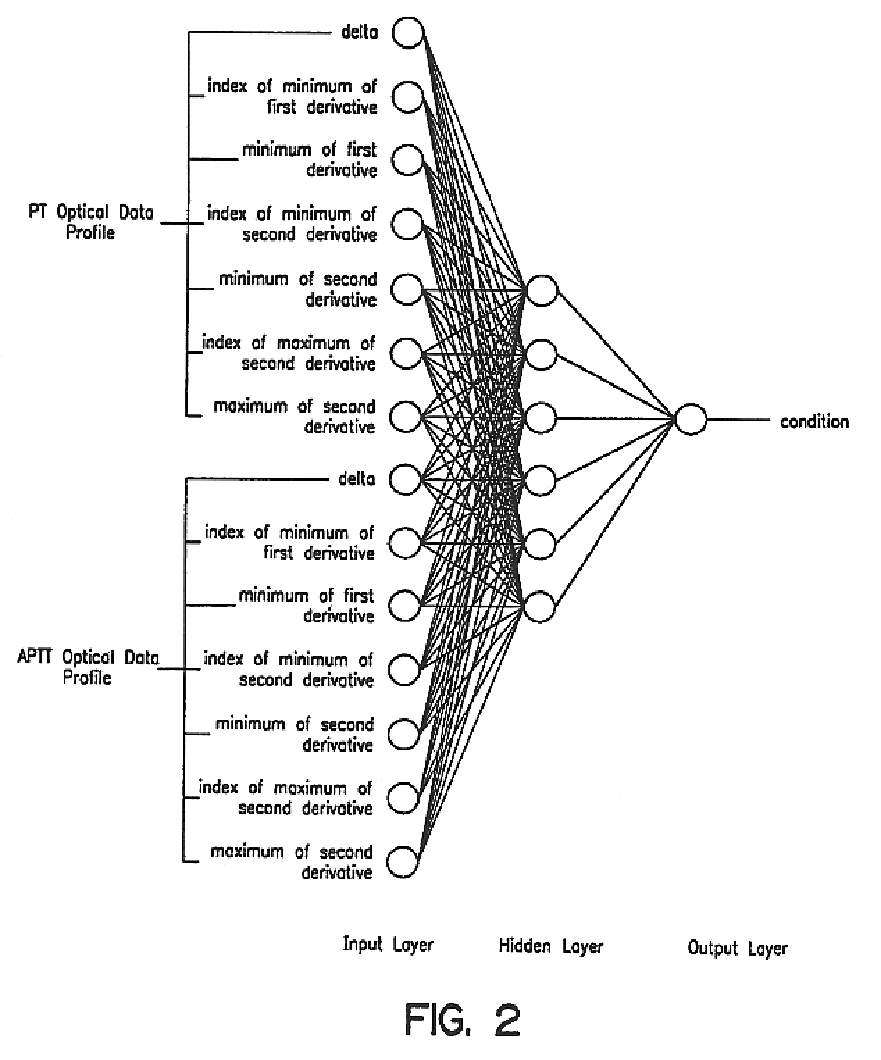Method and apparatus for predicting the presence of haemostatic dysfunction in a patient sample
- Summary
- Abstract
- Description
- Claims
- Application Information
AI Technical Summary
Benefits of technology
Problems solved by technology
Method used
Image
Examples
example 1
Prediction of Heparin in Sample
[0069]This example shows a set of predictor variables that adequately describe screening assay optical profiles, develops an optimal neural network design, and determines the predictive capabilities of an abnormal condition associated with thrombosis / hemostasis (in this case for the detection of heparin) with a substantial and well-quantified test data set.
[0070]Simplastin™ L, Platelin™ L, calcium chloride solution (0.025 M), imidazole buffer were obtained from Organon Teknika Corporation, Durham, N.C., 27712, USA. All plasma specimens were collected in 3.2% or 3.8% sodium citrate in the ratio of one part anticoagulant to nine parts whole blood. The tubes were centrifuged at 2000 g for 30 minutes and then decanted into polypropylene tubes and stored at −80° C. until evaluated. 757 specimens were prepared from 200 samples. These specimens were tested by the following specific assays: FII, FV, FVII, FVIII, FIX, FX, FXI, FXII, heparin, fibrinogen, plasmin...
example 2
Factor VIII
[0087]Similar tests were run as in Example 1. As can be seen in FIGS. 10 and 11, two training sessions were conducted for predicting a Factor VIII condition in an unknown sample. FIG. 10 is a receiver operator characteristic plot related to predicting an abnormality in relation to Factor VIII. In FIG. 10, everything below 30% activity was indicated as positive, and everything above 30% was indicated as negative. Cutoff values other than 30% could also be used. In this Example, the activity percentage has a known accuracy of approximately + or −10%. In FIG. 11, the actual percent activity was utilized as the output.
example 3
[0088]As can be seen in FIG. 12, the method of the present invention was run similar to that as in Example 2, where here an abnormality in Factor X concentration was predicted from unknown samples. Everything below 30% activity was indicated as positive, and everything above 30% was indicated as negative. Cutoff values other than 30% could also be used.
[0089]The results of the cross-validation sample sets throughout the experiments indicate that the sample size was sufficient for the network to generalize. While the random distribution of the training and cross-validation sets were held constant throughout the experiments presented, other distributions have been used. These distributions, while all yielding different results, still lead to the same general conclusion.
[0090]Many alternatives for or additions to the set of predictor variables were explored. This included coefficients of a curve fitted to the data profile, pattern recognition, and clot time-based parameters. Lo...
PUM
 Login to View More
Login to View More Abstract
Description
Claims
Application Information
 Login to View More
Login to View More - R&D
- Intellectual Property
- Life Sciences
- Materials
- Tech Scout
- Unparalleled Data Quality
- Higher Quality Content
- 60% Fewer Hallucinations
Browse by: Latest US Patents, China's latest patents, Technical Efficacy Thesaurus, Application Domain, Technology Topic, Popular Technical Reports.
© 2025 PatSnap. All rights reserved.Legal|Privacy policy|Modern Slavery Act Transparency Statement|Sitemap|About US| Contact US: help@patsnap.com



